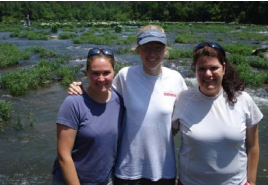
Graduate student researchers Elise Chapman, Julie Jarnigan, and Corianne Tatariw (pictured left to right) at the shoals found within the Fall Line of the Cahaba River. Shoals contain abundant Justicia americana plant beds, interspersed among which are the rare Spider Lily plants.
Understanding variation in the relative importance of nitrogen (N) retention mechanisms from Ridge and Valley headwaters to the Mobile Bay
Drs. Jennifer Edmonds and Behzad Mortazavi, Department of Biological Sciences. This work is currently funded by the USGS through the Alabama Water Resource Research Institute in Auburn, AL.
Widespread nutrient enrichment within the Mobile River Basin of the southeastern US has the potential to increase the delivery of nitrogen (N) and phosphorus (P) to the Gulf Coast. The extent to which nutrient enrichment and associated anoxic conditions persist in the Mobile Bay is largely unknown; however, reducing N transport to Alabama’s coastal waterways will likely ameliorate possible loss of commercial and recreational value due to hypoxic events similar to the Dead Zones widely observed in the Gulf of Mexico.
Through our collaboration between researchers in Tuscaloosa and DISL, we are evaluating the patterns and controls on two important mechanisms for nitrogen retention (denitrification and plant uptake) within the Cahaba River, a key drainage system within the Mobile basin in central Alabama that receives large inputs of anthropogenic N from activity in Birmingham, AL.
Our project includes both laboratory and field activities designed to assess the competition between plant uptake of N and utilization of nitrate by sediment microorganisms. In organic matter-rich sediments experiencing low oxygen conditions, microorganisms will convert nitrate to N2 (g) as they respire, permanently removing N from the ecosystem and preventing it from reaching coastal waters.
Field research for this project has focused on six sites along the river starting above Birmingham in the Ridge and Valley physiographic province and ending downstream ~275 km in the Coastal Plain. Evidence from lab experiments suggests carbon limitation of sediment denitrification at all sites, with the exception of our samples taken from the shoal habitat (see photo). In contrast to the two other physiographic types, the shoals site on the Fall Line had only a small response to C additions, but responded strongly to N addition. This suggests that C limitation of denitrifying bacteria was alleviated by the presence of organic matter rich sediments associated with shoal macrophytes, something we are exploring further in 2010-11. Denitrification potentials measured at coastal sites by the Mortazavi lab as part of this same project also showed evidence of strong N limitation, but no effects of adding C, most likely due to high primary production (i.e., organic matter production) coupled with low water nitrate concentrations.
Future work will relate the patterns in N retention in the Cahaba River to the larger river network and its receiving ecosystem, the Mobile Bay.
